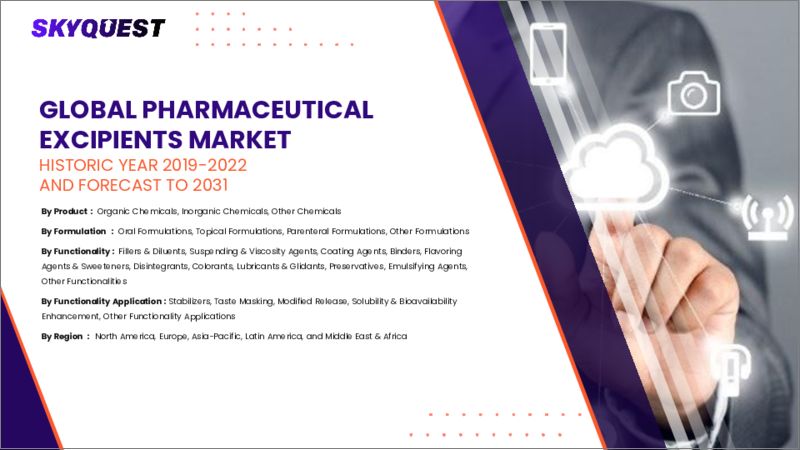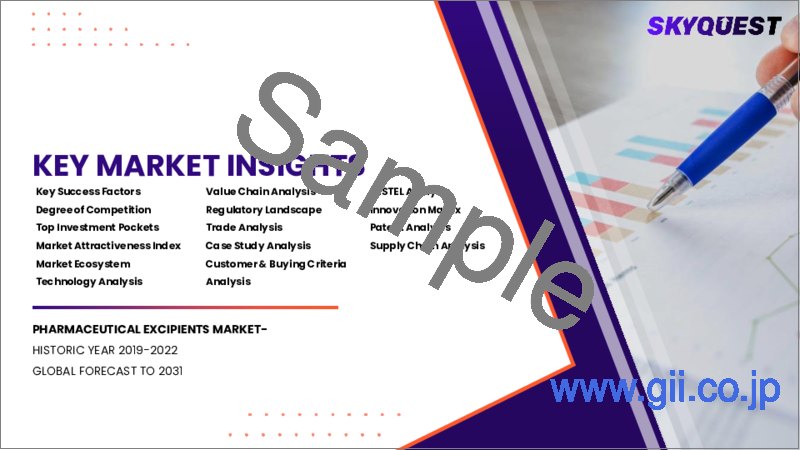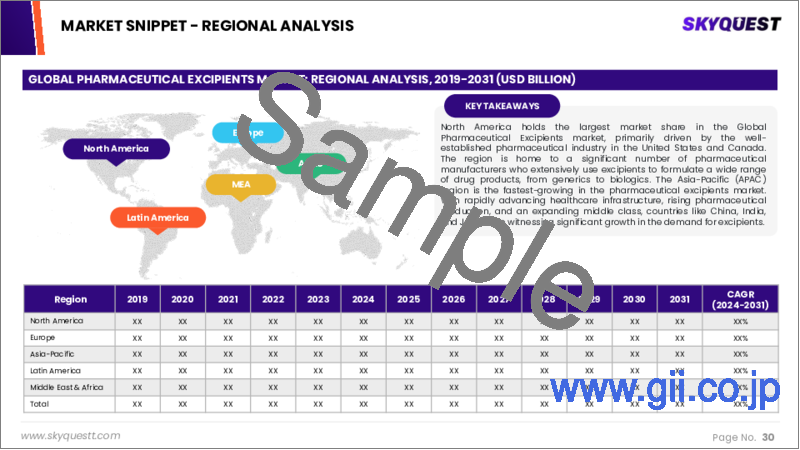|
|
市場調査レポート
商品コード
1561027
医薬品賦形剤の市場規模、シェア、成長分析、製品別、製剤別、機能性用途別、地域別 - 産業予測、2024年~2031年Pharmaceutical Excipients Market Size, Share, Growth Analysis, By Product, By Formulation, By Functionality, By Functionality Application, By Region - Industry Forecast 2024-2031 |
||||||
|
|||||||
| 医薬品賦形剤の市場規模、シェア、成長分析、製品別、製剤別、機能性用途別、地域別 - 産業予測、2024年~2031年 |
|
出版日: 2024年09月19日
発行: SkyQuest
ページ情報: 英文 242 Pages
納期: 3~5営業日
|
- 全表示
- 概要
- 目次
医薬品賦形剤の世界市場規模は2022年に94億8,000万米ドルと評価され、2023年の101億2,000万米ドルから2031年には171億3,000万米ドルに成長し、予測期間(2024-2031年)のCAGRは6.8%で成長する見通しです。
世界の医薬品賦形剤市場は製薬業界の重要な構成要素であり、医薬品の製剤化、安定性、デリバリーを助けるために医薬品有効成分(API)とともに使用される物質を包含しています。結合剤、滑沢剤、崩壊剤、充填剤などの賦形剤は、医薬品の有効性と安全性を確保する上で重要な役割を果たしています。高齢化、慢性疾患の増加、ドラッグデリバリーシステムの進歩などを背景に、高度な製剤に対する需要が高まっているため、市場は拡大しています。さらに、賦形剤は、放出制御療法や標的療法などの新規薬剤製剤の開発にますます使用されるようになっています。当社の調査では、賦形剤の品質に関する規制当局の監視の高まりが市場力学に影響を与え、メーカーがコンプライアンスとイノベーションに注力するよう促していることも明らかになった。
目次
イントロダクション
- 調査の目的
- 定義
- 市場範囲
調査手法
- 情報調達
- 二次データソースと一次データソース
- 市場規模予測
- 市場の想定と制限
エグゼクティブサマリー
- 市場概要見通し
- 供給需要動向分析
- セグメント別機会分析
市場力学と見通し
- 市場力学
- 促進要因
- 機会
- 抑制要因
- 課題
- ポーターの分析
主な市場の考察
- 市場のエコシステム
- 主な投資の分析
- 主な成功要因
- 競合の程度
- 価格分析
- バリューチェーン分析
- 技術分析
- 特許分析
- 貿易分析
- 規制情勢
医薬品賦形剤市場:製品別
- 市場概要
- 有機化学品
- 油脂化学品
- 脂肪アルコール
- ミネラルステアレート
- グリセリン
- その他の油脂化学品
- 炭水化物
- 糖類
- 砂糖
- 糖アルコール
- 人工甘味料
- セルロース
- 微結晶セルロース
- セルロースエーテル
- CMC &クロスカルメロースナトリウム
- セルロースエステル
- スターチ
- 変性デンプン
- 乾燥デンプン
- 変換デンプン
- 石油化学製品
- グリコール
- ポビドン
- 鉱物炭化水素
- アクリルポリマー
- その他の石油化学添加剤
- タンパク質
- その他の有機化学品
- 無機化学品
- リン酸カルシウム
- 金属酸化物
- 岩塩
- 炭酸カルシウム
- 硫酸カルシウム
- その他の無機化学品
- その他の化学品
医薬品賦形剤市場:製剤別
- 市場概要
- 経口製剤
- 錠剤
- カプセル
- ハードゼラチンカプセル
- ソフトゼラチンカプセル
- 液体製剤
- その他の経口製剤
- 局所用製剤
- 非経口製剤
- その他の製剤
医薬品賦形剤市場:機能別
- 市場概要
- 充填剤と希釈剤
- 懸濁剤および粘性剤
- コーティング剤
- バインダー
- 香料・甘味料
- 崩壊剤
- 着色剤
- 潤滑剤と滑剤
- 防腐剤
- 乳化剤
- その他の機能
医薬品賦形剤市場:機能用途別
- 市場概要
- 安定剤
- 味覚マスキング
- 修正リリース
- 溶解性とバイオアベイラビリティの向上
- その他の機能用途
医薬品賦形剤市場規模:地域別
- 市場概要
- 北米
- 米国
- カナダ
- 欧州
- ドイツ
- スペイン
- フランス
- 英国
- イタリア
- その他欧州地域
- アジア太平洋地域
- 中国
- インド
- 日本
- 韓国
- その他アジア太平洋地域
- ラテンアメリカ
- ブラジル
- その他ラテンアメリカ地域
- 中東・アフリカ(MEA)
- GCC諸国
- 南アフリカ
- その他中東・アフリカ地域
競合情勢
- 上位5社の比較
- 主要企業の市場ポジショニング(2023年)
- 主な市場企業が採用した戦略
- 市場における最近の活動
- 主要企業の市場シェア(2023年)
主要企業プロファイル
- BASF SE(Germany)
- Ashland Inc.(US)
- Evonik Industries AG(Germany)
- Kerry Group PLC(Ireland)
- Roquette Freres(France)
- Merck KGaA(Germany)
- Associated British Foods PLC(UK)
- ADM(US)
- Wacker Chemie AG(Germany)
- Air Liquide(France)
- Dow(US)
- Lubrizol Corporation(Berkshire Hathaway)(US)
- Colorcon(US)
- DFE Pharma(Germany)
- Innophos(US)
- J. Rettenmaier & Sohne GmbH+Co KG(Germany)
- Actylis(US)
- Meggle GmbH & Co. KG(Germany)
- Fuji Chemical Industries Co., Ltd.(Japan)
- Corel Pharma Chem(India)
Global Pharmaceutical Excipients Market size was valued at USD 9.48 billion in 2022 and is poised to grow from USD 10.12 billion in 2023 to USD 17.13 billion by 2031, growing at a CAGR of 6.8% in the forecast period (2024-2031).
The global pharmaceutical excipients market is a vital component of the pharmaceutical industry, encompassing substances used alongside active pharmaceutical ingredients (APIs) to aid in drug formulation, stability, and delivery. Excipients, including binders, lubricants, disintegrants, and fillers, play a crucial role in ensuring the effectiveness and safety of medications. The market is expanding due to the increasing demand for sophisticated drug formulations, driven by an aging population, rising incidence of chronic diseases, and advancements in drug delivery systems. Additionally, excipients are being increasingly used in developing novel drug formulations, such as controlled-release and targeted therapies. Our study also reveals that growing regulatory scrutiny regarding the quality of excipients is influencing market dynamics, pushing manufacturers to focus on compliance and innovation.
Top-down and bottom-up approaches were used to estimate and validate the size of the Pharmaceutical Excipients Market and to estimate the size of various other dependent submarkets. The research methodology used to estimate the market size includes the following details: The key players in the market were identified through secondary research, and their market shares in the respective regions were determined through primary and secondary research. This entire procedure includes the study of the annual and financial reports of the top market players and extensive interviews for key insights from industry leaders such as CEOs, VPs, directors, and marketing executives. All percentage shares split, and breakdowns were determined using secondary sources and verified through Primary sources. All possible parameters that affect the markets covered in this research study have been accounted for, viewed in extensive detail, verified through primary research, and analyzed to get the final quantitative and qualitative data.
Pharmaceutical Excipients Market Segmental Analysis
Global Pharmaceutical Excipients Market is segmented on the basis of product, formulation, functionality, functionality application, and region. By product, market is segmented into organic chemicals, inorganic chemicals, other chemicals. By functionality, market is segmented into fillers & diluents, suspending & viscosity agents, coating agents, binders, flavoring agents & sweeteners, disintegrants, colorants, lubricants & glidants, preservatives, emulsifying agents, other functionalities. By functionality application, market is segmented into stabilizers, taste masking, modified release, solubility & bioavailability enhancement, other functionality applications. By region, the market is segmented into North America, Europe, Asia Pacific, Middle East and Africa, and Latin America.
Drivers of the Pharmaceutical Excipients Market
The pharmaceutical excipients market is strongly driven by the rising demand for generic drugs, especially in developing economies. As patents for blockbuster drugs expire, the production of generics is expanding, providing affordable treatment options globally. Generic drugs, which replicate the active ingredients of branded medications, rely heavily on excipients for their formulation to ensure stability, effectiveness, and safety. In markets such as India and China, where generics dominate, the demand for high-quality excipients is growing. Governments in these regions are also promoting the use of generics to reduce healthcare costs, further driving excipient demand. This trend ensures that excipients play a critical role in making medications accessible and affordable, while maintaining pharmaceutical quality standards.
Restraints in the Pharmaceutical Excipients Market
One of the key restraints affecting the pharmaceutical excipients market is stringent regulatory requirements. Excipients, although considered inactive, are subject to rigorous regulations to ensure that they do not negatively affect the quality, safety, or efficacy of the drug. Regulatory bodies such as the U.S. FDA and the European Medicines Agency impose strict guidelines for excipient use, requiring extensive testing to confirm their stability, compatibility, and safety in drug formulations. These regulations increase compliance costs for excipient manufacturers, creating a barrier to market entry for new and innovative excipients. Moreover, the regulatory process can be lengthy, often delaying the introduction of new excipients. Additionally, differences in regulatory standards across regions complicate the market, making global compliance a challenge. This stringent oversight, while ensuring drug safety, limits the speed of innovation and market expansion for excipient manufacturers.
Market Trends of the Pharmaceutical Excipients Market
A major trend in the pharmaceutical excipients market is the rising focus on biopharmaceuticals. Biopharmaceuticals, including biologics like monoclonal antibodies, proteins, and vaccines, require specialized excipients to ensure their stability, delivery, and efficacy. Unlike traditional small-molecule drugs, biopharmaceuticals present unique formulation challenges due to their sensitivity to temperature, pH, and biological interactions. This growing biopharmaceutical sector is driving innovation in excipient development, with companies focusing on creating excipients tailored to the specific needs of biologics. For instance, excipients that offer enhanced protection against degradation during storage and transportation are in high demand. As biopharmaceuticals continue to grow in prominence, particularly in developed markets like North America and Europe, the demand for these specialized excipients is expected to increase significantly.
Table of Contents
Introduction
- Objectives of the Study
- Definitions
- Market Scope
Research Methodology
- Information Procurement
- Secondary & Primary Data Sources
- Market Size Estimation
- Market Assumptions & Limitations
Executive Summary
- Market Overview Outlook
- Supply Demand Trend Analysis
- Segmental Opportunity Analysis
Market Dynamics & Outlook
- Market Dynamics
- Drivers
- Opportunities
- Restraints
- Challenges
- Porters Analysis
- Competitive rivalry
- Threat of Substitute Products
- Bargaining Power of Buyers
- Threat of New Entrants
- Bargaining Power of Suppliers
Key Market Insights
- Ecosystem of the Market
- Top Investment Analysis
- Key Success Factor
- Degree of Competition
- Pricing Analysis
- Value Chain Analysis
- Technology Analysis
- Patent Analysis
- Trade Analysis
- Regulatory Landscape
Pharmaceutical Excipients Market by Product
- Market Overview
- Organic Chemicals
- Oleochemicals
- Fatty Alcohols
- Mineral Stearates
- Glycerin
- Other Oleochemicals
- Carbohydrates
- Sugars
- Actual Sugars
- Sugar Alcohols
- Artificial Sweeteners
- Cellulose
- Microcrystalline Cellulose
- Cellulose Ethers
- Cmc & Croscarmellose Sodium
- Cellulose Esters
- Starch
- Modified Starch
- Dried Starch
- Converted Starch
- Petrochemicals
- Glycols
- Povidones
- Mineral Hydrocarbons
- Acrylic Polymers
- Other Petrochemical Excipients
- Proteins
- Other Organic Chemicals
- Inorganic Chemicals
- Calcium Phosphate
- Metal Oxides
- Halites
- Calcium Carbonate
- Calcium Sulfate
- Other Inorganic Chemicals
- Other Chemicals
Pharmaceutical Excipients Market by Formulation
- Market Overview
- Oral Formulations
- Tablets
- Capsules
- Hard-Gelatin Capsules
- Soft-Gelatin Capsules
- Liquid Formulations
- Other Oral Formulations
- Topical Formulations
- Parenteral Formulations
- Other Formulations
Pharmaceutical Excipients Market by Functionality
- Market Overview
- Fillers & Diluents
- Suspending & Viscosity Agents
- Coating Agents
- Binders
- Flavoring Agents & Sweeteners
- Disintegrants
- Colorants
- Lubricants & Glidants
- Preservatives
- Emulsifying Agents
- Other Functionalities
Pharmaceutical Excipients Market by Functionality Application
- Market Overview
- Stabilizers
- Taste Masking
- Modified Release
- Solubility & Bioavailability Enhancement
- Other Functionality Applications
Pharmaceutical Excipients Market Size by Region
- Market Overview
- North America
- USA
- Canada
- Europe
- Germany
- Spain
- France
- UK
- Italy
- Rest of Europe
- Asia Pacific
- China
- India
- Japan
- South Korea
- Rest of Asia-Pacific
- Latin America
- Brazil
- Rest of Latin America
- Middle East & Africa (MEA)
- GCC Countries
- South Africa
- Rest of MEA
Competitive Landscape
- Top 5 Player Comparison
- Market Positioning of Key Players, 2023
- Strategies Adopted by Key Market Players
- Recent Activities in the Market
- Key Companies Market Share (%), 2023
Key Company Profiles
- BASF SE (Germany)
- Company Overview
- Business Segment Overview
- Financial Updates
- Key Developments
- Ashland Inc. (US)
- Company Overview
- Business Segment Overview
- Financial Updates
- Key Developments
- Evonik Industries AG (Germany)
- Company Overview
- Business Segment Overview
- Financial Updates
- Key Developments
- Kerry Group PLC (Ireland)
- Company Overview
- Business Segment Overview
- Financial Updates
- Key Developments
- Roquette Freres (France)
- Company Overview
- Business Segment Overview
- Financial Updates
- Key Developments
- Merck KGaA (Germany)
- Company Overview
- Business Segment Overview
- Financial Updates
- Key Developments
- Associated British Foods PLC (UK)
- Company Overview
- Business Segment Overview
- Financial Updates
- Key Developments
- ADM (US)
- Company Overview
- Business Segment Overview
- Financial Updates
- Key Developments
- Wacker Chemie AG (Germany)
- Company Overview
- Business Segment Overview
- Financial Updates
- Key Developments
- Air Liquide (France)
- Company Overview
- Business Segment Overview
- Financial Updates
- Key Developments
- Dow (US)
- Company Overview
- Business Segment Overview
- Financial Updates
- Key Developments
- Lubrizol Corporation (Berkshire Hathaway) (US)
- Company Overview
- Business Segment Overview
- Financial Updates
- Key Developments
- Colorcon (US)
- Company Overview
- Business Segment Overview
- Financial Updates
- Key Developments
- DFE Pharma (Germany)
- Company Overview
- Business Segment Overview
- Financial Updates
- Key Developments
- Innophos (US)
- Company Overview
- Business Segment Overview
- Financial Updates
- Key Developments
- J. Rettenmaier & Sohne GmbH + Co KG (Germany)
- Company Overview
- Business Segment Overview
- Financial Updates
- Key Developments
- Actylis (US)
- Company Overview
- Business Segment Overview
- Financial Updates
- Key Developments
- Meggle GmbH & Co. KG (Germany)
- Company Overview
- Business Segment Overview
- Financial Updates
- Key Developments
- Fuji Chemical Industries Co., Ltd. (Japan)
- Company Overview
- Business Segment Overview
- Financial Updates
- Key Developments
- Corel Pharma Chem (India)
- Company Overview
- Business Segment Overview
- Financial Updates
- Key Developments





